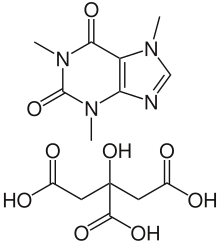
Back سترات الكافيين Arabic Citrat de cafeïna Catalan Kafeina citrato EO Citrato de cafeína Spanish Kofeiinisitraatti Finnish Citrate de caféine French Կոֆեինի ցիտրատ HY Kafein sitrat ID クエン酸カフェイン Japanese କେଫିନ ସାଇଟ୍ରେଟ OR
 | |
| Clinical data | |
|---|---|
| Trade names | Cafcit, Gencebok, Cafnea, others |
| AHFS/Drugs.com | Monograph |
| License data | |
| Routes of administration | By mouth, intravenous (IV) |
| ATC code | |
| Legal status | |
| Legal status | |
| Identifiers | |
| |
| CAS Number | |
| PubChem CID | |
| ChemSpider | |
| UNII | |
| KEGG | |
| ChEMBL | |
| CompTox Dashboard (EPA) | |
| ECHA InfoCard | 100.125.472 |
| Chemical and physical data | |
| Formula | C14H18N4O9 |
| Molar mass | 386.317 g·mol−1 |
| 3D model (JSmol) | |
| |
| |
| (verify) | |
Caffeine citrate, sold under the brand name Cafcit among others, is a medication used to treat a lack of breathing in premature babies.[5] Specifically it is given to babies who are born at less than 35 weeks or weigh less than 2 kilograms (4.4 lb) once other causes are ruled out.[6] It is given by mouth or slow injection into a vein.[5]
Side effects can include problems feeding, increased heart rate, low blood sugar, necrotizing enterocolitis, and kidney problems.[5][6] Testing blood caffeine levels is occasionally recommended.[5] Although it is often referred to as a citric acid salt of caffeine,[7] as implied by its name, caffeine citrate in fact consists of cocrystals of the two components.[8] Caffeine citrate is in the xanthine family of medication.[6] It works by stimulating the respiratory centers in the brain.[5]
Caffeine was discovered in 1819.[9] It is on the World Health Organization's List of Essential Medicines.[10] The intravenous form may also be taken by mouth.[11]
In June 2020, the Committee for Medicinal Products for Human Use (CHMP) of the European Medicines Agency (EMA) recommended the approval of Gencebok.[12] It was approved for use in the European Union in August 2020.[3]
- ^ "Regulatory Decision Summary - Peyona". Health Canada. 23 October 2014. Retrieved 5 June 2022.
- ^ "Cafcit- caffeine citrate injection". DailyMed. 3 January 2020. Retrieved 27 August 2020.
- ^ a b "Gencebok EPAR". European Medicines Agency (EMA). 19 June 2020. Retrieved 27 August 2020.
- ^ "Gencebok Product information". Union Register of medicinal products. Retrieved 3 March 2023.
- ^ a b c d e "Caffeine; Caffeine and Sodium Benzoate Injection; Caffeine Citrate". The American Society of Health-System Pharmacists. Archived from the original on 16 July 2017. Retrieved 8 December 2016.
- ^ a b c World Health Organization (2009). Stuart MC, Kouimtzi M, Hill SR (eds.). WHO Model Formulary 2008. World Health Organization. p. 485. hdl:10665/44053. ISBN 9789241547659.
- ^ Donn SM, Sinha SK (2012). Manual of Neonatal Respiratory Care. Springer Science & Business Media. p. 457. ISBN 9781461421559. Archived from the original on 30 December 2016.
- ^ Cite error: The named reference
Smit_2015was invoked but never defined (see the help page). - ^ Brown N (2015). In Silico Medicinal Chemistry: Computational Methods to Support Drug Design. Royal Society of Chemistry. p. 20. ISBN 9781782621638. Archived from the original on 29 December 2016.
- ^ World Health Organization (2019). World Health Organization model list of essential medicines: 21st list 2019. Geneva: World Health Organization. hdl:10665/325771. WHO/MVP/EMP/IAU/2019.06. License: CC BY-NC-SA 3.0 IGO.
- ^ Ainsworth SB (2014). Neonatal Formulary: Drug Use in Pregnancy and the First Year of Life (7 ed.). John Wiley & Sons. p. 120. ISBN 9781118819517. Archived from the original on 30 December 2016.
- ^ "Gencebok: Pending EC decision". European Medicines Agency (EMA). 25 June 2020. Archived from the original on 27 June 2020. Retrieved 26 June 2020.